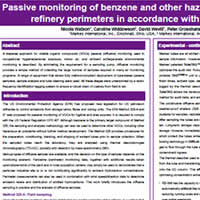Resumo do Pôster:
1. Introduction
US EPA Method 3251 was proposed for passive monitoring of VOCs for fugitive and area sources. It is required to comply with the US Federal Regulation CFR 402. Although benzene is the primary target compound of Method 325, the sampling and analysis methodology can also be used to determine other VOCs, including other hazardous air pollutants without further method development. The Method 325 provides procedures for the preparation, conditioning, blanking, and shipping of sorbent tubes prior to sample collection. When the sampled tubes reach the laboratory, they are analysed using thermal desorption–gas chromatography (TD–GC), typically with detection by mass spectrometry (MS).
Various types of diffusive sampler are available, and the decision on the type of sampler depends on the monitoring scenario. Fenceline monitoring data, together with ancillary results taken upwind/downwind of the plant and in local population centers, may simply be used to demonstrate that a particular industrial site is or is not contributing significantly to ambient hydrocarbon concentrations. Perimeter measurements can also be used in combination with wind speed/direction data to determine emission levels and distribution of emitted hydrocarbons. This work briefly introduces the theory of diffusive samplers, the diffusive sampling in practice and the analysis of diffusive samples.
2. Purpose
Describe a stepwise approach to complying with US EPA Method 325 for monitoring VOCs air pollutants.
3. Method
Prior to analysis, the sorbent tubes are tested under stop flow conditions to ensure sample integrity. A pre-purging of the tubes removes oxygen and prolongs their life. Internal standards are additioned to the tubes, to check analytical integrity. The unobtrusive diffusive samplers are placed in the local to be monitored for extended time periods to monitor key ‘criteria’ pollutants such as benzene. The size and shape of the area to be monitored is important to determining how the samplers should be placed and how many should be used. After sampling, the sample is refocused on a focusing trap, which is desorbed and the VOCs are transferred into the capillary GC column.
4. Results and Discussion
The monitoring of VOCs at a refinery perimeter is discussed. Method 325 states that up to 24 monitoring locations should be distributed around the perimeter (fenceline) of the refinery, in a pattern that depends upon the size and shape of the site (Figure 1).
Method 325 states the use of sorbent tubes packed with Carbograph 1TD, Carbopack B, or Carbopack X (or equivalent, i.e. Carbograph 5TD). Field blank tubes must be deployed at the same time as the sampling tubes. When handling the large number of tubes required by Method 325 it’s recommended that the tubes are all etched with a unique ID number in barcode and numerical format for tracking of sample information. This prevents manual transcription errors and optimises the audit trail. Method 325 states that tubes must remain sealed at all times after sampling, to avoid contamination and/or analyte loss. Long-term storage caps are used to seal blank and sampled tubes throughout transport and storage. A representative TD–GC–MS analysis of contaminated refinery fenceline air is shown in Figure 2. To determine the concentration of benzene, five-point calibration curves are used to calculate the mass on tube from the peak abundance.
5. Conclusion
Passive sampling for ambient air monitoring, as implemented in the new EPA Method 325 is a robust method, because changes in ambient conditions (temperature, wind speed, humidity, interferences) have minimal impacts on uptake rates. It is also versatile, because sorbent tubes can be used for pumped or passive sampling, and offer quantitative sampling and release of compounds over a wide volatility range. Samplers can be re-used more than 50 times.
6. References
- U.S. Environmental Protection Agency - New and Revised 40 CFR Part 63, Appendix A, Test Methods: Proposed 325A and 325B for Passive Fenceline Monitoring for Fugitive and Area Sources. March 2015.
- U.S. Code of Federal Regulations (CFR). Title 40: Protection of Environment.
|

